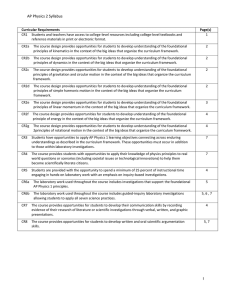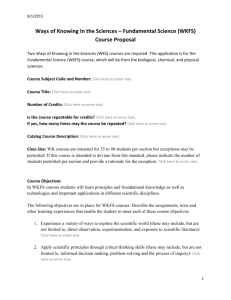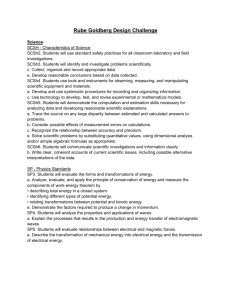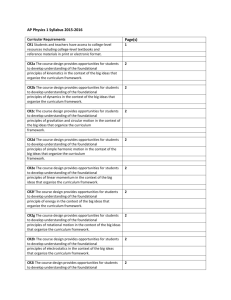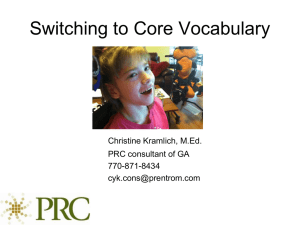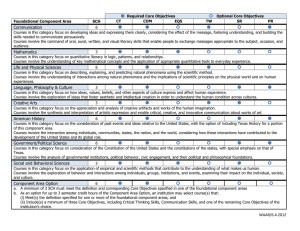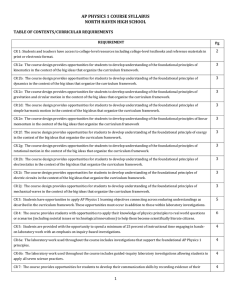CJSH AP Physics I
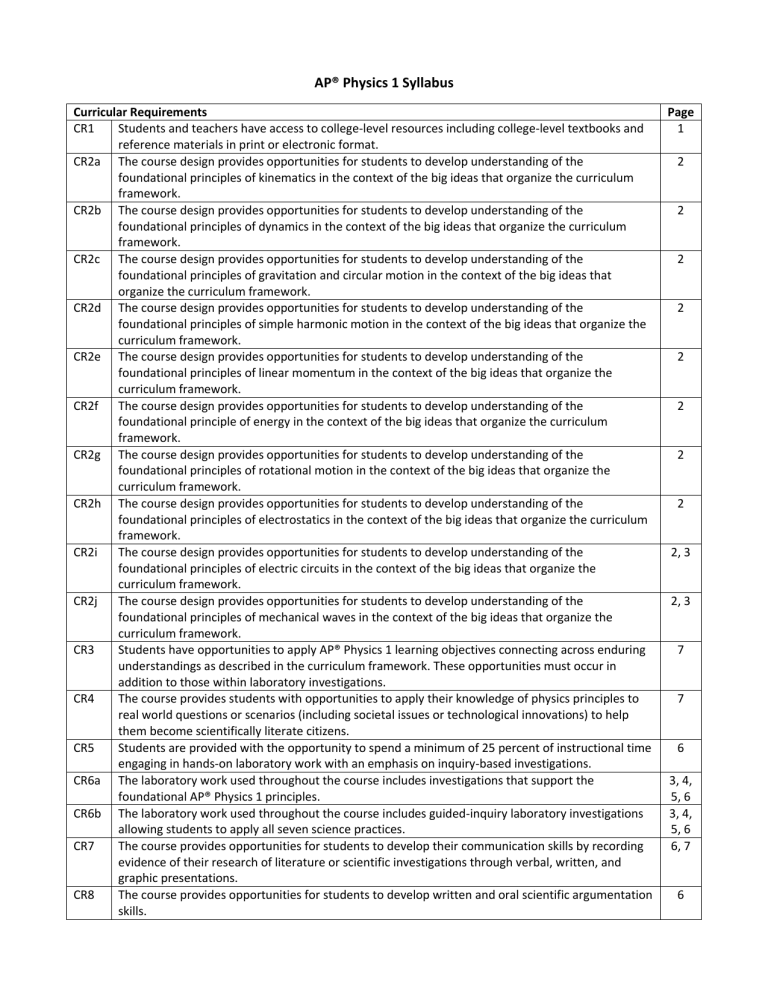
AP® Physics 1 Syllabus
Curricular Requirements
CR1 Students and teachers have access to college-level resources including college-level textbooks and reference materials in print or electronic format.
CR2a The course design provides opportunities for students to develop understanding of the foundational principles of kinematics in the context of the big ideas that organize the curriculum framework.
CR2b The course design provides opportunities for students to develop understanding of the foundational principles of dynamics in the context of the big ideas that organize the curriculum framework.
CR2c The course design provides opportunities for students to develop understanding of the foundational principles of gravitation and circular motion in the context of the big ideas that organize the curriculum framework.
CR2d The course design provides opportunities for students to develop understanding of the foundational principles of simple harmonic motion in the context of the big ideas that organize the curriculum framework.
CR2e The course design provides opportunities for students to develop understanding of the foundational principles of linear momentum in the context of the big ideas that organize the curriculum framework.
CR2f The course design provides opportunities for students to develop understanding of the foundational principle of energy in the context of the big ideas that organize the curriculum framework.
CR2g The course design provides opportunities for students to develop understanding of the foundational principles of rotational motion in the context of the big ideas that organize the curriculum framework.
CR2h The course design provides opportunities for students to develop understanding of the foundational principles of electrostatics in the context of the big ideas that organize the curriculum framework.
CR2i The course design provides opportunities for students to develop understanding of the foundational principles of electric circuits in the context of the big ideas that organize the curriculum framework.
CR2j The course design provides opportunities for students to develop understanding of the foundational principles of mechanical waves in the context of the big ideas that organize the curriculum framework.
CR3 Students have opportunities to apply AP® Physics 1 learning objectives connecting across enduring understandings as described in the curriculum framework. These opportunities must occur in addition to those within laboratory investigations.
CR4 The course provides students with opportunities to apply their knowledge of physics principles to real world questions or scenarios (including societal issues or technological innovations) to help them become scientifically literate citizens.
CR5 Students are provided with the opportunity to spend a minimum of 25 percent of instructional time engaging in hands-on laboratory work with an emphasis on inquiry-based investigations.
CR6a The laboratory work used throughout the course includes investigations that support the foundational AP® Physics 1 principles.
CR6b The laboratory work used throughout the course includes guided-inquiry laboratory investigations allowing students to apply all seven science practices.
CR7 The course provides opportunities for students to develop their communication skills by recording evidence of their research of literature or scientific investigations through verbal, written, and graphic presentations.
CR8 The course provides opportunities for students to develop written and oral scientific argumentation skills.
Page
1
2
2
2
2
2
2
2
2
2, 3
2, 3
7
7
6
3, 4,
5, 6
3, 4,
5, 6
6, 7
6
Course Introduction
AP® Physics 1 is an algebra-based course in general physics that meets for 60 minutes each day for the entire school year, with 25% of instructional time allotted for laboratory investigations. General physics topics presented during the course closely follow those outlined by the College Board and also mirrors an introductory level university physics course. AP® Physics 1 is organized around six big ideas that bring together the fundamental science principles and theories of general physics. These big ideas are intended to encourage students to think about physics concepts as interconnected pieces of a puzzle. The solution to the puzzle is how the real world around them actually works. The students will participate in inquiry-based explorations of these topics to gain a more conceptual understanding of these physics concepts. Students will spend less of their time in traditional formula-based learning and more of their effort will be directed to developing critical thinking and reasoning skills.
Textbook
Serway, Raymond A., and Vuille, Chris. College Physics . Tenth Edition. Stamford, CT:
Cengage Learining, 2014. [CR1]
Additional Resources/Materials
1.
OpenStax College, College Physics . OpenStax College. 21 June 2012. [CR1]
2.
Lewin, Walter. 8.01 Physics I: Classical Mechanics, Fall 1999 . (MIT
OpenCourseWare: Massachusetts Institute of
Technology), http://ocw.mit.edu/courses/physics/8-01-physics-i-classical-mechanicsfall-1999. License: Creative Commons BY-NC-SA. [CR1]
3.
Data Studio Software v. 1.7. Pasco Scientific. Roseville, CA. [CR1]
4.
PhET Interactive Simulations. University of Colorado Bolder. @ phet.colorado.edu.
[CR1]
Big Ideas for AP® Physics 1
Big Idea 1: Objects and systems have properties such as mass and charge. Systems may have internal structure.
Big Idea 2: Fields existing in space can be used to explain interactions.
Big Idea 3: The interactions of an object with other objects can be described by forces.
Big Idea 4: Interactions between systems can result in changes in those systems.
Big Idea 5: Changes that occur as a result of interactions are constrained by conservation laws.
Big Idea 6: Waves can transfer energy and momentum from one location to another without the permanent transfer of mass and serve as a mathematical model for the description of other phenomena.
The big ideas for AP® Physics 1 are correlated to the content of the course and to the lab and inquiry-based investigations done throughout the school year in the following table.
CR1—Students and teachers have access to college-level resources including collegelevel textbooks and reference materials in print or electronic format.
1
Outline of AP® Physics 1 Principles and Correlation to Big Ideas (BI):
Physics Principles
Kinematics [CR2a]
Chap 1: Introduction (Mathematical Concepts)
Chap 2: Motion in One Dimension
BI
1
BI
2
BI
3
BI
4
BI
5
✓
✓ ✓
✓ ✓
BI
6
Chap 3: Vectors & Two Dimensional Motion
Dynamics of Force and Motion [CR2b]
Chap 4: Newton’s Laws of Motion ✓ ✓ ✓ ✓
✓ ✓ ✓ ✓ Chap 7: Circular Motion, Rotation, and Gravity
Universal Law of Gravitation [CR2c]
Chap 4: Newton’s Laws of Motion
Chap 7: Rotational Motion & the Law of Gravity
✓ ✓ ✓ ✓
✓ ✓ ✓ ✓
Simple Pendulum and Mass-Spring Systems
[CR2d]
Chap 5: Newton’s Laws of Motion
Chap 13: Vibrations & Waves
Impulse, Linear Momentum, and Conservation of Linear Momentum [CR2e]
Chap 6: Momentum & Collisions
Work, Energy, Conservation of Energy, and
Power [CR2f]
Chap 5: Work, Energy, Conservation of Energy, and
Power
Rotational Kinematics, Conservation of Angular
Momentum, and Rotational Energy [CR2g]
Chap 8: Rotational Motion & the Law of Gravity
✓ ✓ ✓
✓ ✓
✓ ✓ ✓
✓ ✓ ✓
Chap 9: Torque & Rotational Dynamics
Electrostatics [CR2h]
Chap 18: Conservation of Electric Charge, Electric
Forces & Fields
Chap 19: Electrostatics; Conductors, Capacitors
✓ ✓ ✓
✓ ✓ ✓
✓ ✓ ✓
Simple DC Circuits [CR2i]
Chap 20: Electric circuits, Ohm’s law, Kirchhoff’s laws
Waves and Sound [CR2j]
Chap 16: Mechanical Waves and Sound
✓
✓ ✓
✓
✓ Chap 17: The Principle of Linear Superposition and
Interference Phenomena
AP® Test Review for the time remaining until the AP® Test.
Time after AP® Test will be spent on Relativity, Astronomy, and other topics.
CR2a—The course design provides opportunities for students to develop understanding of the foundational principles of kinematics in the context of the big ideas that organize the curriculum framework.
CR2b—The course design provides opportunities for students to develop understanding of the foundational principles of dynamics in the context of the big ideas that organize the curriculum framework.
CR2c—The course design provides opportunities for students to develop understanding of the foundational principles of gravitation and circular motion in the context of the big ideas that organize the curriculum framework.
CR2d—The course design provides opportunities for students to develop understanding of the foundational principles of simple harmonic motion in the context of the big ideas that organize the curriculum framework.
CR2e—The course design provides opportunities for students to develop understanding of the foundational principles of simple harmonic motion in the context of the big ideas that organize the curriculum framework.
CR2f—The course design provides opportunities for students to develop understanding of the foundational principle of energy in the context of the big ideas that organize the curriculum framework.
CR2g—The course design provides opportunities for students to develop understanding of the foundational principles of rotational motion in the context of the big ideas that organize the curriculum framework.
CR2h—The course design provides opportunities for students to develop understanding of the foundational principles of electric circuits in the context of the big ideas that organize the curriculum framework.
2
Outline of AP® Physics 1 Labs and Investigations with Correlation to Big Ideas (BI):
Physics Principles and AP® Science
Practices [CR6a] [CR6b]
Kinematics
1.
Car Velocity Lab: students determine the velocity of a car driving on the road.
Students design the investigation method and analyze the results in terms of accuracy and precision.
Guided-Inquiry Investigation
Science Practices: 1.4, 2.1, 2.2, 2.3, 3.3, 4.1,
4.2, 4.3, 4.4, 5.1, 5.3, 6.2
2.
Car Velocity Lab: students determine the velocity of a car driving on the road.
Students design the investigation method and analyze the results in terms of accuracy and precision.
Guided-Inquiry Investigation
Science Practices: 1.4, 2.1, 2.2, 2.3, 3.3, 4.1,
4.2, 4.3, 4.4, 5.1, 5.3, 6.2
3.
Vector addition. Students use direction cards to arrive at a predetermined location; then mix up the cards and repeat the activity to determine the effect of addition order on the result.
Guided-Inquiry Investigation
Science Practices: 1.4, 1.5, 2.1, 2.2, 3.1, 4.3,
4.4, 5.1, 6.1, 6.2, 7.2
4.
Students use a cart on an air track and associated software to repeat, by moving the cart with their hands, a given velocity vs. time curve and a given acceleration vs. time curve.
Guided-Inquiry Investigation
Science Practices: 1.1, 1.2, 3.2, 3.3, 4.4, 5.1,
5.2
5.
Projectile Motion: Students determine the initial velocity of balls, of varying masses, launched horizontally.
Science Practices: 1.1, 1.2, 1.4, 2.1, 2.2, 2.3,
3.3, 4.1, 4.2, 4.3, 4.4, 5.1, 6.1, 6.2
Dynamics of Force and Motion
6.
Free Fall: Students use motion sensor equipment to determine the acceleration of an object in free fall.
Science Practices: 1.1, 1.2, 1.4, 2.1, 2.2, 2.3,
3.3, 4.1, 4.2, 4.3, 4.4, 5.1, 6.1, 6.2
BI
1
BI
2
BI
3
BI
4
BI
5
BI
6
✓
✓
✓
✓
✓
✓
✓
✓
✓
CR2i—The course design provides opportunities for students to develop understanding of the foundational principles of electric circuits in the context of the big ideas that organize the curriculum framework.
CR2j—The course design provides opportunities for students to develop understanding of the foundational principles of electric circuits in the context of the big ideas that organize the curriculum framework.
CR6a—The laboratory work used throughout the course includes investigations that support the foundational AP® Physics 1 principles.
CR6b—The laboratory work used throughout the course includes guided-inquiry laboratory investigations allowing students to apply all seven science practices.
3
CR2j— The course design provides opportunities for students to develop understanding of the foundational principles of electric circuits in the context of the big ideas that organize the curriculum framework.
Physics Principles and AP® Science
Practices [CR6a] [CR6b]
7.
Resolution and Composition of Force
Vectors: Students use a force table and spring scales to measure forces and to insert a missing force to produce translational equilibrium.
Science Practices: 1.2, 1.4, 2.1, 2.2, 3.3, 4.3,
4.4, 5.1, 6.1, 6.2
8.
Air Track and Pulley: Students use an air track and pulley system to determine the acceleration for the system.
Science Practices: 1.1, 1.2, 1.4, 2.1, 2.2, 2.3,
3.3, 4.1, 4.2, 4.3, 4.4, 5.1, 5.2, 6.2
9.
Friction: Students use different pairs of surfaces, varied normal forces, and varied contact surface areas to determine the effect these parameters have on friction forces.
Guided Inquiry
Science Practices: 1.4, 2.1, 2.2, 3.1, 4.2, 4.3,
4.4, 5.1, 5.2, 6.1, 7.2
10.
Inclined Planes Forces and Friction: students determine what effect an incline has on the value of friction and determine coefficients of friction for various objects.
Science Practices: 1.4, 2.1, 2.2, 3.1, 4.2, 4.3,
4.4, 5.1, 5.2, 6.1, 7.2
11.
Inclined Planes Forces and Friction: students determine what effect an incline has on the value of friction and determine coefficients of friction for various objects.
Science Practices: 1.4, 2.1, 2.2, 3.1, 4.2, 4.3,
4.4, 5.1, 5.2, 6.1, 7.2
Universal Law of Gravitation
12.
Galileo Ramps: students use ramps at different angles to determine what happens to the acceleration.
Science Practices: 1.1, 1.4, 2.1, 2.2, 3.2, 4.1,
4.4, 5.1, 5.2, 6.2, 7.2
13.
Centripetal Force: Students rotate a rubber stopper, weight, and string system to determine the relationship to derive the equation for centripetal force
Science Practices: 1.4, 2.1, 2.2, 2.3, 3.1, 4.2,
4.3, 4.4, 5.1, 5.2, 6.1, 7.2
BI
1
✓
✓
✓
✓
✓
✓
BI
2
BI
3
BI
4
BI
5
BI
6
✓ ✓
✓
✓
✓
✓
✓
✓
✓
✓
✓
✓
✓
✓
✓
✓
Simple Pendulum and Mass-Spring Systems
14.
Hooke’s Law: students determine the ✓ ✓ relationship between distance stretched and force.
Science Practices: 1.1, 1.4, 2.1, 2.2, 3.3, 4.1,
4.4, 5.1, 6.2, 7.2
CR6a—The laboratory work used throughout the course includes investigations that support the foundational AP® Physics 1 principles.
CR6b—The laboratory work used throughout the course includes guided-inquiry laboratory investigations allowing students to apply all seven science practices.
4
Physics Principles and AP® Science
Practices [CR6a] [CR6b]
15.
Pendulum Properties: students determine what factors affect the period of a pendulum.
Guided-Inquiry Investigation
Science Practices: 1.1, 2.1, 2.2, 3.1, 4.1, 4.2,
4.4, 5.1, 5.2, 6.1, 6.2, 7.2
Impulse, Linear Momentum, and
Conservation of Linear Momentum
16.
Momentum: Students use air tracks and motion sensors to verify the conservation of momentum for elastic and perfectly inelastic collisions.
Science Practices: 1.1, 1.2, 1.4, 2.1, 2.2, 3.3,
4.1, 4.2, 4.3, 4.4, 5.1, 5.3, 6.1, 6.2, 6.4, 7.2
Electrostatics
21.
Coulomb’s Law: students use electroscopes to determine the relationship between force, charge, and distance.
Science Practices: 1.1, 1.4, 2.1, 2.2, 3.1, 4.1,
4.2, 4.3, 4.4, 5.1, 5.2, 6.1, 6.2, 7.2
BI
1
BI
2
BI
3
BI
4
BI
5
BI
6
✓ ✓
✓ ✓ ✓
Work, Energy, and Conservation of Energy
17.
Ballistic Pendulum: Students determine the ✓ ✓ ✓ initial speed of a horizontally projected object into a block and string pendulum.
Guided-Inquiry Investigation
Science Practices: 1.1, 1.4, 2.1, 2.2, 3.1, 3.2,
4.1, 4.2, 4.4, 5.1, 5.2, 6.1, 6.2, 7.2
18.
Work-Energy Friction: Students throw a weight into a box that then slides across the
✓ ✓ ✓ floor. Students then use the data gathered from the exercise to determine the initial velocity of the weight that is thrown
Guided-Inquiry Investigation
Science Practices:
Rotational Kinematics and Conservation of
Angular Momentum
19.
Torque Lab: Students determine factors that affect the rotational motion of an object.
Science Practices: 1.1, 1.4, 2.1, 2.2, 3.3, 4.1,
5.1, 6.2
20.
Rolling Cylinders: students determine how the type of cylinder rolled affects time of roll.
Science Practices: 1.1, 1.4, 2.1, 2.2, 3.3, 4.1,
5.1, 6.2
✓
✓
✓
✓
✓
✓
✓
✓
✓ ✓ ✓ ✓
CR6a—The laboratory work used throughout the course includes investigations that support the foundational AP® Physics 1 principles.
CR6b—The laboratory work used throughout the course includes guided-inquiry laboratory investigations allowing students to apply all seven science practices.
5
Physics Principles and AP® Science
Practices [CR6a] [CR6b]
Simple DC Circuits
22.
Electric Circuit Lab: Using simple DC circuits (parallel and series), students determine the relationship between voltage, current, and resistance (Ohm’s Law)
Open-Inquiry Investigation
Science Practices: 1.1, 1.4, 2.1, 2.2, 3.1, 4.1,
4.2, 4.4, 5.1, 5.2, 6.1, 6.2, 7.2
Waves and Sound
23.
Resonance: Students use a frequency generator, oscilloscope, and an open-ended tube to investigate resonance and the speed of sound.
Science Practices: 1.1, 1.4, 2.1, 2.2, 3.1, 4.1,
4.2, 4.4, 5.1, 5.2, 6.1, 6.2, 7.2
BI
1
BI
2
BI
3
BI
4
BI
5
BI
6
✓ ✓
✓
Additional Course Information
Laboratory Exercises & Classwork
Labs are all “hands-on” and placed throughout the instructional year. Students will spend at least 25% of class time in laboratory investigations. [CR5] Labs can be either teacher directed or student directed/open-ended. During a teacher-directed lab, the students are given instruction on the operation of lab equipment and guidance in the process of the experiment. Student-directed labs are when the students are given an objective, e.g. “Determine the acceleration due to gravity on
Earth,” and standard materials needed to conduct a lab. Students are allowed to create their own experimental design and collect data, which can be analyzed through graphical methods. These inquiry-based investigations or student-directed labs have an extra element added to the lab report. After these labs, each student group must present their results to the class and defend their results. They will also evaluate one other group's approach to the problem and offer a critique of their procedures and results. [CR8]
Students work in lab groups, but each student must submit a lab report which is turned in the day after the conclusion of each activity, then graded and returned.
The report must include the following components: [CR7]
Statement of the problem
Hypothesis
Discussion or outline of how the procedure will be carried out
Data collected from the experiment
Data analysis
Conclusion including error analysis
Peer review (if included in this lab)
CR6a—The laboratory work used throughout the course includes investigations that support the foundational AP® Physics 1 principles.
CR6b—The laboratory work used throughout the course includes guided-inquiry laboratory investigations allowing students to apply all seven science practices.
CR5—Students are provided with the opportunity to spend a minimum of 25 percent of instructional time engaging in hands-on laboratory work with an emphasis on inquiry-based investigations.
CR8—The course provides opportunities for students to develop written and oral scientific argumentation skills.
CR7—The course provides opportunities for students to develop their communication skills by recording evidence of their research of literature or scientific investigations through verbal, written, and graphic presentations.
6
Students are required to keep the reports in an organized lab notebook or folder.
This lab notebook/folder will be kept by the students for the entire year and must include the completed lab reports as well as the raw data tables and any notes made during the execution of the labs done in the course. [CR7]
Two lab investigations during the year are extended projects that require using data collected by outside sources. Students will utilize this data to find out answers to questions posed by the instructor and also questions they formulate themselves. The two lab investigations are:
1.
Car Crash Physics: As an attorney and a physics teacher, I am aware of the types of physics-related issues involved with a car crash. A problem will be posed to the students involving a person hurt in a car crash, but the insurance company claims that there was not enough force generated during the crash to cause harm to a person. They will research information needed and write a report detailing their conclusions. Each group will present their findings to the class and also review and critique another group’s conclusions and methods used to come up with their answer. As one group presents their findings as experts, the other group will be acting as the insurance company trying to find holes in their argument. [CR4]
2.
Kepler Telescope Exoplanet Discovery: The Kepler telescope has been discovering evidence about new planets around other stars for the last few years. Some of this data is posted on the Internet and we will use it to determine properties of these planets. Students will have a new planet to investigate and determine as many physical properties about that planet as possible form the data set. The investigation requires the students to utilize Learning Objectives 2.B.2.1, 3.A.2.1, 3.A.4.2, 3.B.2.1, 3.C.1.2, and
4.A.1.1. [CR3]
CR7—The course provides opportunities for students to develop their communication skills by recording evidence of their research of literature or scientific investigations through verbal, written, and graphic presentations.
CR4—The course provides students with opportunities to apply their knowledge of physics principles to real world questions or scenarios
(including societal issues or technological innovations) to help them become scientifically literate citizens.
CR3—Students have opportunities to apply AP®
Physics 1 learning objectives connecting across enduring understandings as described in the curriculum framework.
These opportunities must occur in addition to those within laboratory investigations.
7
